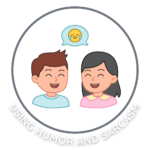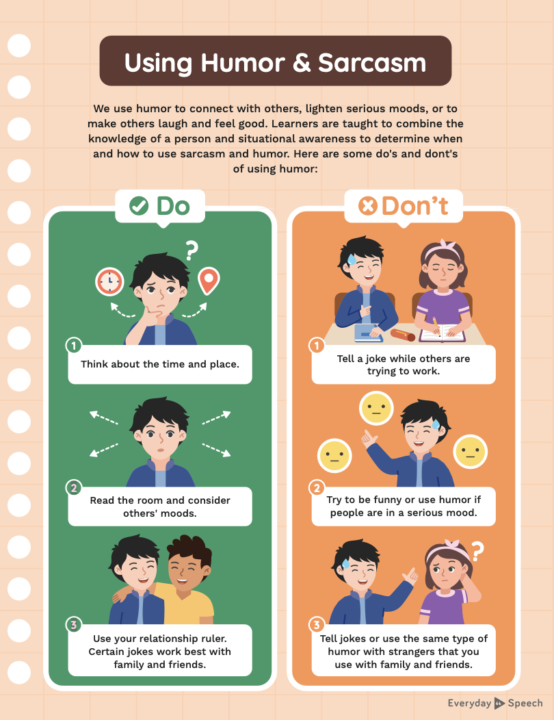
Middle school students are at a critical developmental stage where social skills and communication become increasingly important. One of the trickiest areas for them to navigate is understanding the appropriate use of humor and sarcasm. Humor can be a powerful tool for building relationships and lightening the mood, but when used inappropriately, it can lead to misunderstandings or hurt feelings. That’s where Everyday Speech’s Humor and Sarcasm for Middle Schoolers poster comes in.
This visual tool is designed to help educators teach students when and how to use humor and sarcasm appropriately. In this blog, we will explore how you can use the poster to teach these skills effectively, why it’s essential for middle schoolers to grasp these concepts, and provide tips for integrating humor and sarcasm education into your classroom.
Why Teach Humor and Sarcasm in Middle School?
Humor and sarcasm are common parts of social interaction. For middle school students, learning how to use these tools appropriately is crucial for several reasons:
- Building Positive Relationships: Humor can strengthen friendships and help students feel more connected to their peers. But understanding when humor is welcome and when it’s not is essential.
- Avoiding Misunderstandings: Sarcasm, in particular, can easily be misunderstood. When students aren’t aware of the subtleties of tone, timing, and social context, their jokes can come across as rude or hurtful.
- Enhancing Emotional Intelligence: Teaching students how to read social cues, like understanding someone’s mood or the setting, helps them become more emotionally intelligent. This skill benefits them not just socially, but academically and in future professional environments as well.
Using the Humor and Sarcasm for Middle Schoolers poster, educators can visually break down these nuanced social skills, making them more accessible to students who may struggle to grasp these concepts through discussion alone.
What’s on the Humor and Sarcasm Poster?
The Humor and Sarcasm for Middle Schoolers poster breaks down the appropriate use of humor into several do’s and don’ts that are easy for students to understand. Here are the main points covered:
- Read the Room: This tip emphasizes the importance of being aware of the social environment. Is it the right time for humor? Are the people around you in the mood for a joke? The poster encourages students to assess the situation before using humor or sarcasm.
- Use Your Relationship Ruler: Not all jokes are appropriate for all situations. This section reminds students that certain types of humor may work with close friends and family but could be inappropriate or offensive when used with strangers or in more formal settings.
- Think About the Time and Place: Timing is everything. The poster reminds students that trying to be funny while others are working, listening, or focusing on something serious can be disruptive and disrespectful.
- Dos and Don’ts of Humor: The poster provides a clear list of actions students should and shouldn’t take when using humor. This simple, straightforward format helps reinforce appropriate behaviors while making it clear what to avoid.
By visually presenting these concepts, the poster serves as a constant reminder in the classroom of how to use humor and sarcasm in a way that fosters connection rather than conflict.

How to Integrate the Poster into Your Lesson Plan
Here are several ways you can use the Humor and Sarcasm for Middle Schoolers poster to teach these social skills:
1. Introduce the Topic with Discussion
Start by introducing the concept of humor and sarcasm to your students. Ask them questions like, “What makes something funny?” or “When is sarcasm a bad idea?” These open-ended questions can help you gauge your students’ current understanding and spark a conversation about how humor can be positive or negative, depending on how it’s used.
Use the poster to guide this discussion, pointing out the key takeaways about reading the room, understanding relationships, and considering the time and place for humor.
2. Role-Playing Scenarios
Once students understand the basics, have them practice using humor and sarcasm appropriately by role-playing different scenarios. For example, create a situation where one student is trying to make others laugh, but the setting isn’t right—like during a serious classroom discussion. Then, ask the student to think about how they could adjust their behavior based on the tips from the poster.
Role-playing allows students to practice making quick judgments about the appropriateness of humor and gives them hands-on experience in social situations.
3. Reflect on Humor in Media
Encourage students to think critically about humor in their everyday lives. Have them watch a short clip from a TV show, movie, or social media, and analyze how humor is used. Is it appropriate? Who is the target audience for this joke? How could the use of sarcasm be misunderstood?
This activity can help students apply the principles from the Humor and Sarcasm for Middle Schoolers poster to real-life examples they encounter daily.
4. Use the Poster as an Ongoing Reference
The great thing about visual tools like the Humor and Sarcasm poster is that they don’t have to be a one-time lesson. Hang it up in your classroom and refer back to it whenever needed. If you notice a student using humor inappropriately, you can point them back to the poster as a gentle reminder.
Unlock all of our visual tools by signing up for your free trial today – no credit card required!
Access the full Social Communication Curriculum HERE!
Instant access to thousands of no-prep social skills activities, over 1000+ video lessons, and engaging games designed to enhance learning and development.
Fostering a Positive Classroom Environment
Incorporating lessons on humor and sarcasm isn’t just about preventing inappropriate jokes; it’s about fostering a positive school culture. When students grasp how to use humor respectfully, they feel more confident in social situations and contribute to a supportive learning environment.
By teaching students how to use humor and sarcasm appropriately, you’re helping them develop emotional intelligence, empathy, and social awareness.
Conclusion
Teaching middle school students the appropriate use of humor and sarcasm can be a challenging but rewarding task. Everyday Speech’s Humor and Sarcasm for Middle Schoolers poster offers educators an engaging and effective tool. With its visual reminders, this poster helps students develop the skills needed to navigate humor in a way that’s respectful.
Related Blog Posts:
Navigating Middle School: Enhancing Social Skills Through Videos
Teaching Middle School Students to Stay Calm and Solve Problems
Promoting Mental Well-being: SEL Lessons for Middle School Students





